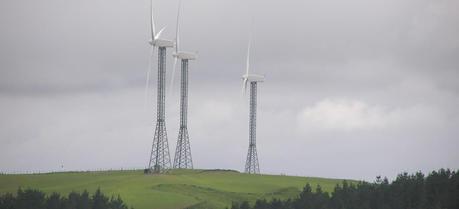 Wind turbines in the Manawatu region, New Zealand. (Credit: Flickr @ Neville10 http://www.flickr.com/photos/42198161@N02/)
Wind turbines in the Manawatu region, New Zealand. (Credit: Flickr @ Neville10 http://www.flickr.com/photos/42198161@N02/)
Researchers at the University of Colorado Boulder have performed the first direct measurements of turbulence dissipation rates of wind turbines in real-world conditions. Wake turbulence might dissipate faster than commonly thought and in ways existing weather models do not reflect, their study suggests.
According to the abstract of their paper (see footnote), because of the dense arrays at most wind farms, the region of disturbed flow downstream of an individual turbine leads to reduced power production and increased structural loading for its leeward counterparts. Currently, wind farm wake modeling, and hence turbine layout optimization, suffer from an unacceptable degree of uncertainty, largely because of a lack of adequate experimental data for model validation.
Julie Lundquist, CU-Boulder assistant professor of atmospheric and oceanic sciences, presented these findings during a scientific session on weather-driven renewable energy at the fall meeting of the American Geophysical Union in San Francisco.
“We care about wakes not just because they’re beautiful, but studying them will help us understand how to produce more power and minimize turbine maintenance costs,” Lundquist said.
Before this study, turbulence dissipation rates had been directly measured only in wind tunnels. Estimates of turbulence dissipation rates from scanning lidar have also been carried out at this location in a previous study in which Lundquist’s research group collaborated with CU’s Cooperative Institute for Research in Environmental Sciences and the National Oceanic and Atmospheric Administration’s Earth Systems Research Laboratory.
Nearly 100 hours of wake measurements were collected with long-range Doppler lidar at the National Wind Technology Center at the National Renewable Energy Laboratory in the Turbine Wake and Inflow Characterization Study (TWICS).
In their paper, scientists present quantitative procedures for determining critical parameters from this extensive dataset—such as the velocity deficit, the size of the wake boundary, and the location of the wake centerline—and categorize the results by ambient wind speed, turbulence, and atmospheric stability. Despite specific reference to lidar, the methodology is general and could be applied to extract wake characteristics from other remote sensor datasets, as well as computational simulation output.
“Although wind-tunnel measurements of wind speed can represent what happens in the real atmosphere, scaling wind-tunnel measurements of turbulence is more difficult,” she added. “We need to compare real-world measurements to wind-tunnel measurements to understand how that scaling works for turbulence.”
Matthew L. Aitken, Robert M. Banta, Yelena L. Pichugina, Julie K. Lundquist (2014). Quantifying wind turbine wake characteristics from scanning remote sensor data Journal of Atmospheric and Oceanic Technology DOI: 10.1175/JTECH-D-13-00104.1
